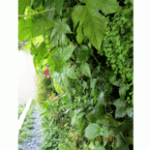
Additional Resources
For additional information regarding the “San Francisco Residential Living Wall” please contact Michelle Bond of Thumbellina Gardens at: thumbellinaG@comcast.net. Learn about Tournesol Siteworks in the Greenroof & Greenwall Directory.
San Francisco is famous for its hills. A newly remodeled modern house sits on a bottom of a hillside in Pacific Heights with a significant retaining wall at the rear of the property. The backyard is sunken into the hill edged with three large, tall concrete walls surrounded by greenery; the space is terraced into two large open spaces with raised beds along the backside. The previous newly installed landscaping was nice, but lacked imagination in design, planting and artistry.
The owner/designer’s mission was to develop the space into a striking display of vertical gardens that would take advantage of the walls to their utmost possibilities. The goal was to create and display a living wall that brings biodiversity, beauty and enjoyment to the owner’s familial lifestyle. This planting display is modeled after a natural vertical garden similar to a woodland cliff on a north facing hill in California. The vision of a mixture of subtropical plants with northwestern ferns and fern- allies gives the wall its lush looking state.
Installed in late November 2010, the wall at the back of the yard was built up to be level across the top in order to accommodate the living wall which is 12 feet high and 27.5 feet wide. The framework of the wall uses Tournesol Siteworks modules and bracket systems and had been in planning for six months prior to the installation of the 96 VGM modules with 1,536 plants used to cover the back yard.
The wall consists of 96 modules measuring 20″x20″ and 10″ deep. These modules have felt bags that were filled a growing medium made of a locally available 50/50 mix of coir based “Ultra Potting Soil” and Perlite. Tournesol Siteworks typically recommends a less-organic lightweight mix (90/10 inorganic/organic). Each module was planted with 16 4″ plants. The planting was based on a planting plan developed from a sketch drawn by the homeowner and designer Michelle Bond of Thumbellina Gardens in San Francisco. Because of the very specific planting plan, each module was marked with a number when planted. The planting plan has over 75 varieties of shade loving plants which were appropriate for the north facing hillside of the site.
While planting the modules, the rails were hung. Unplanted modules in their frames were used to verify the spacing and location. Once the planting was done, the plants were left to grow into the media. Relatively large plants were installed one per window. They let these grow in for about 3 weeks prior to installation. Had they started with smaller plugs, the grow-in time would have been significantly longer. During the planting process, the plants were slowly acclimated to their vertical position by way of tilting. After 3 weeks of planting, each module was tilted 45 degrees to acclimate the plants. It took 3-4 weeks for the plants to perk up and settle into their new modular pockets.
At the big install, the installation team started with the bottom row and went up level by level (with the exception of the outermost row), allowing for the easiest installation of the irrigation. Tournesol Siteworks’ recommended irrigation layout was followed, running a horizontal main line. The laterals were run up the rails. At the top of each box a multiport drip emitter was installed, with individual emitters run to every box. The fertigation system was installed with the irrigation system to replenish nutrients in the soil otherwise lost by water constantly dripping down through the modules.
After 6 weeks, all the modules were hung vertically into the bracket system. After 6 months, the wall is approximately 85% filled in. With the help of the fertigation system, the plants are thriving – the only plants that have had difficulty were the Serissa, Vrisea, and the Alocasia. The current maintenance schedule (6 months after the wall was installed) is as follows – Thumbellina Gardens checks the pH of the fertilization/ irrigation solution every two weeks, trims once a month, changes the fertilizer mix every 4 months. They’ve verified the pH of the soil just once so far.
 Greenroofs.comConnecting the Planet + Living Architecture
Greenroofs.comConnecting the Planet + Living Architecture














